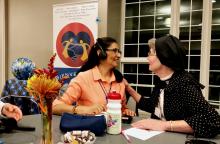As the world population grows toward 8 billion, estimates of the number of victims of human trafficking also rise. Some advocacy groups guess that 40 million people are caught up in modern-day slavery. Crunching some imprecise numbers, it's plausible to say that one in every 200 people on this planet is a victim of human trafficking. One in 8 billion, of course, is one too many.
Statistics often desensitize people to the realities they illustrate. It's easy to look at a number such as 40 million, feel very outnumbered and thus lose hope. That's a response we have to overcome, especially when mentoring young people for advocacy.
We are encouraged from our earliest years to be independent. While it's not unhealthy to urge people to be the best versions of themselves, that message often becomes a call to competition. People want to be the best, like superheroes, and choose to go it alone.
Sisters, who live in community, understand the value of interdependence. Within and beyond their congregations, they share their gifts and develop networks that enable them to do together far more than they ever could do alone. It’s essential to work together to prevent human trafficking, protect its victims and empower its survivors.
You can join in the sisters' work to thwart modern-day slavery by deepening your awareness of indications that a student might be a victim of human trafficking.
Ask students to individually brainstorm lists of gifts and skills they think would be helpful to prevent trafficking, support victims of trafficking or empower its survivors. Tell them that responses can be general or specific. Prime the pump by providing some examples, such as:
- I'm alert to situations around me
- I'm active on social media and can warn people to avoid being trafficked
- I'm a good listener
- I'm a smart shopper and can choose items that aren't made using slave labor
- I'm curious
- I'm a good organizer and can help raise money to support survivors
- I'm outspoken
Assign students to teams of four. Tell students to share their lists with teammates. Teammates can add items to the lists of others.
Give each student a one-foot piece of string or yarn for each item on their list. Instruct them to lay their pieces, along with those of their teammates, horizontally or vertically in a net pattern. If time allows, they can overlap or weave the pieces. Then invite teams to place a small item, such as a phone, wallet or book on the net. Lastly, ask group members to choose a side of the net, grasp its edges and slowly lift it and the item.
Ask the students:
1. How effective was your net in supporting the item you lifted?
2. At any point, did you wish you had more strings in your net? Did you find yourself wishing you had identified more skills or gifts?
3. Were your gifts alone sufficient to lift the item? What other factors came into play?
Conclude by saying: "It takes a lot of gifts and skills to address any problem, including human trafficking. These gifts alone, however, aren't enough. We need to share them and we need to use them. If a burden seems too heavy, it's time to reach out and engage other folks and the gifts they share."
Lord, you remind us that wherever two or more are gathered in your name, you are there among us.
Help us trust that together, empowered by your grace, we can do great things.
Let us freely share our gifts to form networks of hope
So that all may freely live.
Amen.
Please give us your feedback! Fill out a quick survey about this lesson and how we can serve you better. Remember that its title is "Fighting human trafficking across Western Hemisphere"
Tell us what you think about this resource, or give us ideas for other resources you'd like to see, by contacting us at education@globalsistersreport.org
